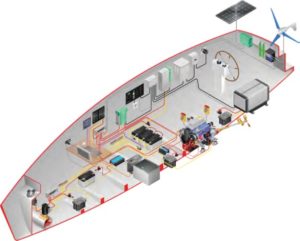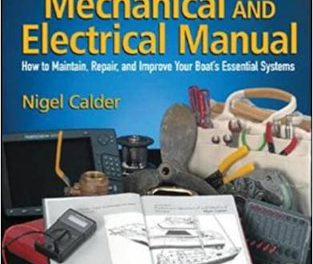Issue 141: Nov/Dec 2021
When we were preparing for a three-year cruise aboard our 1979 Dufour 35, we knew we needed to rewire our boat. But, overwhelmed by the technicolored spaghetti behind our DC panel, and knowing nothing about electrical (save that the electrics on our boat were a mess), we decided to hire an electrician who would guide us through a complete rewiring.
He arrived on a rainy Monday morning, sniffling and sneezing, and proceeded to open the AC panel. He fumbled and dropped his trouble light into the AC compartment. A burst of sparks erupted, frying our inverter and blowing the main dock breaker. To top it all off, three days later I came down with a miserable cold.
This experience provided sufficient motivation to teach myself marine electrics. I waded through clunky YouTube videos, struggled to decipher wiring diagrams, and puzzled over multimeter readings. My education began in our home port and lasted the three years while we sailed offshore. Turns out, it could largely have been condensed into a few hours, if only I’d had access to something like the new online course Boat Electrics 101.

The electrical systems aboard modern sailboats have become increasingly complex. For those interested in understanding them, the online course Boat Electrics 101 might be the path to enlightenment. Photo courtesy Boat Electrics 101
Designed for the recreational boat owner, the course covers everything, including effecting your own electrical installations and repairs, the basics of electricity, and how to design your onboard electrical system and rewire your boat. It delves into the nitty-gritty of how to read and create your own circuit diagram, select and install cables, and establish proper connections.
The course is the brainchild of marine experts Nigel Calder, Jan C. Athenstädt, and Michael Herrmann. Calder and Herrmann have been longtime members of American Boat and Yacht Council (ABYC) and International Organization for Standardization (ISO) committees, which work on the electrical standards for recreational boats.
Their goal was to create a course with the most accurate and reliable information about boat systems on the internet. According to them, YouTubers and bloggers sometimes get it wrong, giving dangerous DIY electrical advice. Their expertise complies with ABYC E-11 and ISO 13297 standards. If you follow their advice and document your work, your boat electrical systems should comply with insurance requirements.
While learning to do your own electrical may seem intimidating, this course makes it accessible and engaging with videos, text, illustrations, and animations. As a text-based learner, I like that I didn’t have to watch every video to get the information I needed.
Real-life examples keep the theory relevant. In one module, Calder drives a screw through an unprotected wire and connected the battery. The cable immediately goes up in flames, filling the room with smoke and providing a stark reminder of the importance of overcurrent protection (fuses or circuit breakers).
I recommend Boat Electrics 101 to anyone going offshore or planning to rewire their boat. Its accurate information is compellingly presented and available wherever there’s a reliable internet connection. For more information: boathowto.com/boat-electrics-101.
Thank you to Sailrite Enterprises, Inc., for providing free access to back issues of Good Old Boat through intellectual property rights. Sailrite.com





